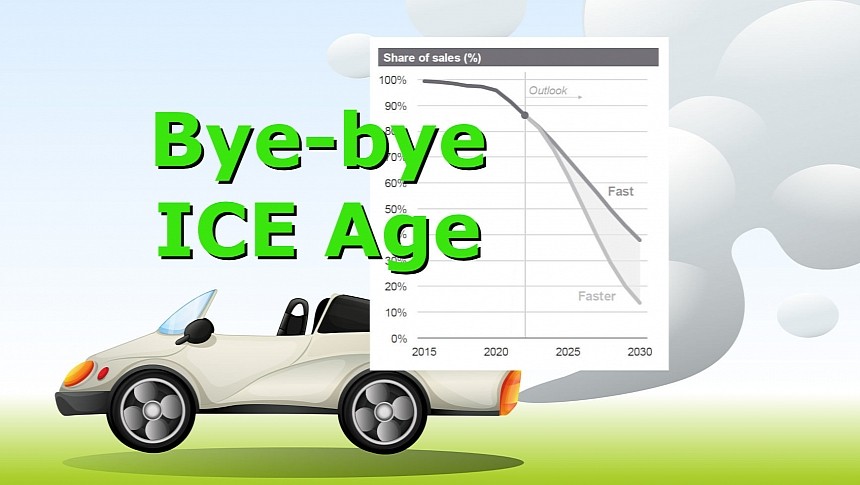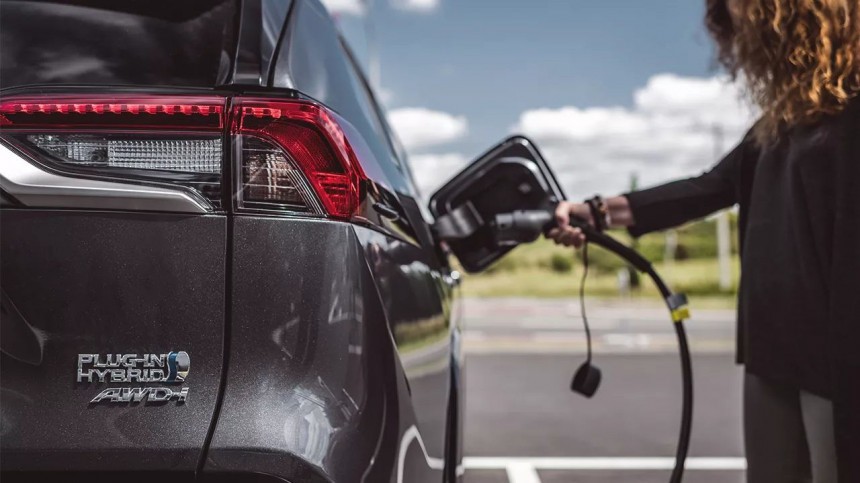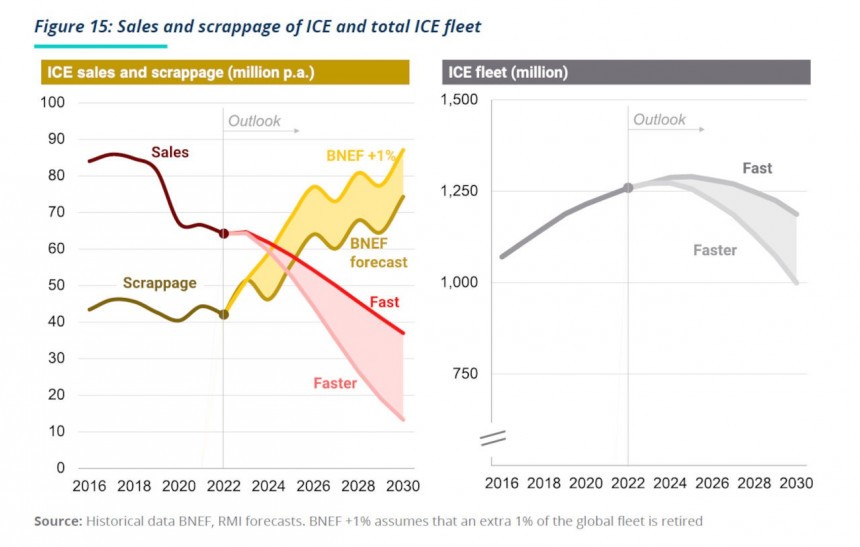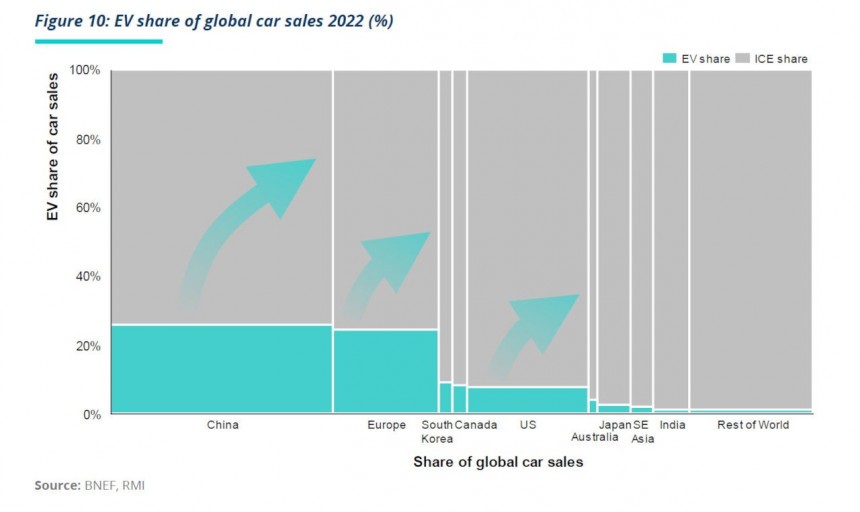The report compiled by Rocky Mountain Institute and Bezos Earth Fund is basically saying what many others have stated so far: EVs are on the rise, and ICE vehicle sales will soon collapse. But, as with any prediction, there are caveats, uncertainties, and biased assumptions. Let's see the original approach of the "X-change: Cars, The end of the ICE age" report and what we can really expect in the near future.
First of all, you should know that "RMI is an independent, non-partisan, nonprofit organization," so it's not your usual research company whose insights are the basis for many corporations' plans. Because of its mission to "accelerate the clean energy transition and improve lives," you can easily guess that it tends to be more optimistic in its forecasts regarding green technologies than down-to-earth economy-oriented analysts.
This is not bad, but it makes me take their conclusions with a grain of salt. Also, they compiled this report in partnership with Bezos Earth Fund, so their findings had to align with their donor environmental beliefs. Again, this is not a bad thing, but electroheads should not have too high expectations from the car industry after reading this report.
Such a claim makes any electrohead or Greta Thunberg fan out there rejoice, while petrolheads and Big Oil will most likely start ranting about climate change conspiracies or that we can't live without oil. Whatever.
I want to point out that many people tend to overlook the "new car sales market share" detail. I often hear people laughing to my face that there's no way to replace 80% of the around 1.3-1.5 billion ICE vehicles in the world with electric cars by 2030 or even by 2050. And they're damn right – we can't.
What this report and other analysts claim is that every year, the market share of new EV sales is rising. At one point in the future, yearly sales of new EV cars will significantly exceed those of new ICE cars. I tend to believe those forecasting that, by 2050, less than half of all the two-billion-or-so road vehicles existing in the world will be electric.
This leads me to a devilish detail hiding in plain sight in this report: the term "EV" used by RMI doesn't refer to 100% electric cars, as anyone would expect. It is defined as "passenger vehicles and, in line with standard practice, include both battery electric vehicles (BEV) and plug-in hybrid electric vehicles (PHEV)."
I didn't expect this "independent, non-partisan, nonprofit organization" to use established industry's greenwashing propaganda. Because, you know, the car and oil industries are happy when consumers are fooled into thinking a vehicle containing an internal combustion engine is "green."
Maybe that's because this report mainly uses data from BloombergNEF's "Electric Vehicle Outlook 2023" and the International Energy Agency's energy reports. These entities are working with raw data from the industry. Their primary interest is not to convince people to go green but to help companies make the best business decisions based on economic as-realistic-as-possible forecasts.
So, having all these in mind, we should take a look at some interesting points of view RMI is bringing into the big picture.
Most important, though, is the scrappage rate of ICE cars. For instance, around 40 or 50 million cars were scrapped yearly in the last decade. Every year, less than 100 million new cars are sold worldwide. So, the global fleet of cars grew by around 50-60 million per year in the decade until 2017.
The 2022 data shows us that around 64 million new ICE cars were sold worldwide, and about 42 million cars were scrapped. So, the global fleet of cars grew only by 22 million, half the growth recorded prior. BloombergNEF estimates the scrappage rate of ICE cars will increase to 60 or 70 million per year, while sales of new ICE cars are expected to drop further.
Essentially, in just a few years, there's a high chance we'll see more scrapped ICE cars than new ICE cars sold yearly. This means the global ICE car fleet could reach around 1.3 billion by the half of this decade. By 2030, RMI forecasts it will drop to 1.2 billion or even 1 billion, in the most optimistic scenario.
In the meantime, the global fleet of cars will continue to grow because EV sales will increase. BloombergNEF estimates that there are currently over 1.2 billion ICE passenger cars in the world, and only 27 million of them are EVs (electric vehicles and plug-in hybrids, as I mentioned before).
Based on the S-curve theory, RMI estimates that the EV fleet can grow to around 300 million units by 2030, or even more than 400 million units, in the most optimistic scenario. It means that, in 2030, 25% of the global car fleet will most likely be EVs, or even 40% in the most optimistic scenario.
As EV sales rise, ICE car sales drop – I couldn't agree more. RMI expects new EV sales in 2030 will match the new ICE car sales in 2023. This doesn't help much, but here's another remarkable comparison: in 2030, new EV sales could hit around 60 million units yearly, while new ICE car sales will drop under 40 million units.
In the most optimistic scenario, the difference is much higher in 2030: more than 80 million new EV sales vs. less than 15 million new ICE car sales. Indeed, selling five times more EVs than ICE cars seems like a true rEVolution. But don't get me wrong, while I'm an electrohead, it's almost impossible for me to believe such wild forecasts.
But, for now, this is just a very optimistic presumption. Unfortunately, based on this, some big players in the car industry intend to build ICE cars in the long run. For instance, Germany forced convinced the EU to make an exception for the new ICE cars using e-fuels regarding new ICE cars phasing out starting from 2035.
Consequently, other carmakers have high hopes to continue manufacturing internal combustion engines even after 2050. They aim at the slow-developing markets in South America, Asia, and Africa. At the same time, the RMI report states that the "Global South has less fossil fuel infrastructure and can avoid the stranded assets of the fossil fuel era by building out new EV infrastructure."
Of course, one could argue that such reports are subject to future developments in the economic and geopolitical environment. No one can predict the future, but forecasts are usually based on solid trends, realistic resources, and technologically feasible solutions.
In my opinion, RMI's report is not quite a report. It's more of a green propaganda tool, emphasizing the unrealistic, too-optimistic forecasts regarding EV rise and the ICE fall. I wish their conclusions to match the near-future reality.
My reluctance is based on many other optimistic forecasts I saw throughout the years that eventually proved far from the harsh reality. And I tend to believe in hard data, even if I don't like it, instead of idealistic forecasts. RMI is clearly on the idealist boat: "The key global divide in the energy transition […] is between the recalcitrant petrostates and the rest of the world. Between those who want to prop up the status quo and those who want a better world."
This is not bad, but it makes me take their conclusions with a grain of salt. Also, they compiled this report in partnership with Bezos Earth Fund, so their findings had to align with their donor environmental beliefs. Again, this is not a bad thing, but electroheads should not have too high expectations from the car industry after reading this report.
Are EVs in this report 100% electric vehicles?
One of the main assumptions this report is based on is the "clear exponential growth pattern for EV sales." Or the already famous S-curve we've seen with TVs or mobile phones. According to RMI, EVs are expected to get from 1% to 10% of the new car sales market share in around six years, while in the next six years (the same period), they will get to 80% market share.Such a claim makes any electrohead or Greta Thunberg fan out there rejoice, while petrolheads and Big Oil will most likely start ranting about climate change conspiracies or that we can't live without oil. Whatever.
I want to point out that many people tend to overlook the "new car sales market share" detail. I often hear people laughing to my face that there's no way to replace 80% of the around 1.3-1.5 billion ICE vehicles in the world with electric cars by 2030 or even by 2050. And they're damn right – we can't.
What this report and other analysts claim is that every year, the market share of new EV sales is rising. At one point in the future, yearly sales of new EV cars will significantly exceed those of new ICE cars. I tend to believe those forecasting that, by 2050, less than half of all the two-billion-or-so road vehicles existing in the world will be electric.
This leads me to a devilish detail hiding in plain sight in this report: the term "EV" used by RMI doesn't refer to 100% electric cars, as anyone would expect. It is defined as "passenger vehicles and, in line with standard practice, include both battery electric vehicles (BEV) and plug-in hybrid electric vehicles (PHEV)."
Maybe that's because this report mainly uses data from BloombergNEF's "Electric Vehicle Outlook 2023" and the International Energy Agency's energy reports. These entities are working with raw data from the industry. Their primary interest is not to convince people to go green but to help companies make the best business decisions based on economic as-realistic-as-possible forecasts.
So, having all these in mind, we should take a look at some interesting points of view RMI is bringing into the big picture.
More scrapped ICEs lead to a drop in market share
According to RMI, "demand for new ICE vehicles peaked in 2017 and has been falling at 5% a year since." Consequently, "global oil demand to fuel cars reached a peak in 2019." We've heard this before, but because of COVID-19 and Russia's war on Ukraine, we have yet to see if this trend will continue. For now, the car industry really struggles, but the oil industry is kind of thriving.Most important, though, is the scrappage rate of ICE cars. For instance, around 40 or 50 million cars were scrapped yearly in the last decade. Every year, less than 100 million new cars are sold worldwide. So, the global fleet of cars grew by around 50-60 million per year in the decade until 2017.
The 2022 data shows us that around 64 million new ICE cars were sold worldwide, and about 42 million cars were scrapped. So, the global fleet of cars grew only by 22 million, half the growth recorded prior. BloombergNEF estimates the scrappage rate of ICE cars will increase to 60 or 70 million per year, while sales of new ICE cars are expected to drop further.
Essentially, in just a few years, there's a high chance we'll see more scrapped ICE cars than new ICE cars sold yearly. This means the global ICE car fleet could reach around 1.3 billion by the half of this decade. By 2030, RMI forecasts it will drop to 1.2 billion or even 1 billion, in the most optimistic scenario.
Based on the S-curve theory, RMI estimates that the EV fleet can grow to around 300 million units by 2030, or even more than 400 million units, in the most optimistic scenario. It means that, in 2030, 25% of the global car fleet will most likely be EVs, or even 40% in the most optimistic scenario.
As EV sales rise, ICE car sales drop – I couldn't agree more. RMI expects new EV sales in 2030 will match the new ICE car sales in 2023. This doesn't help much, but here's another remarkable comparison: in 2030, new EV sales could hit around 60 million units yearly, while new ICE car sales will drop under 40 million units.
In the most optimistic scenario, the difference is much higher in 2030: more than 80 million new EV sales vs. less than 15 million new ICE car sales. Indeed, selling five times more EVs than ICE cars seems like a true rEVolution. But don't get me wrong, while I'm an electrohead, it's almost impossible for me to believe such wild forecasts.
Is the "ICE age" really coming to an end? Not so fast
What RMI's report misses out on the big picture is the recent developments of e-fuel propaganda. Many in the car industry have high hopes for the e-fuels' decarbonization potential. If they really could slash CO2 emissions "by up to 90%", as advertised by their advocates, this would tremendously reduce pollution from the 1.0-1.2 billion ICE cars presumably still in use in 2030.But, for now, this is just a very optimistic presumption. Unfortunately, based on this, some big players in the car industry intend to build ICE cars in the long run. For instance, Germany forced convinced the EU to make an exception for the new ICE cars using e-fuels regarding new ICE cars phasing out starting from 2035.
Consequently, other carmakers have high hopes to continue manufacturing internal combustion engines even after 2050. They aim at the slow-developing markets in South America, Asia, and Africa. At the same time, the RMI report states that the "Global South has less fossil fuel infrastructure and can avoid the stranded assets of the fossil fuel era by building out new EV infrastructure."
Of course, one could argue that such reports are subject to future developments in the economic and geopolitical environment. No one can predict the future, but forecasts are usually based on solid trends, realistic resources, and technologically feasible solutions.
My reluctance is based on many other optimistic forecasts I saw throughout the years that eventually proved far from the harsh reality. And I tend to believe in hard data, even if I don't like it, instead of idealistic forecasts. RMI is clearly on the idealist boat: "The key global divide in the energy transition […] is between the recalcitrant petrostates and the rest of the world. Between those who want to prop up the status quo and those who want a better world."









